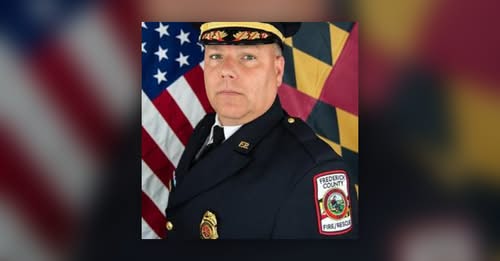He says it provides basic and specialized training for fire & rescue personnel.

Frederick County Fire And Rescue Service Chief Tom Coe
Frederick, Md (KM) The cancellation of in-person training at the National Fire Academy campus in Emmitsburg took a lot of people in the fire service by surprise. The official explanation by federal officials is the programs are being evaluated to see if they conform with the administration’s polices.
Frederick County Fire and Rescue Services Chief Tom Coe commented on that during a recent appearance on WFMD”s “Morning News Express.” “There’s some review and program verification and validation. It’s my hope as a fire chief that the National Fire Academy, and the associated organizations up there, the Emergency Management Institute, which is also a piece of infrastructure of our company, is open for in-person learning,”::he says.
Coe says the country, in the late 1960’s and early 1970’s, had “huge structure fire” problem, especially in the urban areas, which resulted in a lot of fire deaths. “The United States Government put together the Federal Commission on Fire Prevention and Control. which issued a report called ‘America Burning,’” he says. “And that report issued a lot of recommendations on how the fire service in our country could provide for a safer, safer residential situation for our citizens. And one of the outcomes of that was the National Fire Academies.”
He says the National Fire Academy opened in 1979.
“we’re fortunate to have a local fire training academy where our folks receive basic level training in fire and EMS service, our basic hazardous materials training, our basic rescue training,” Coe continues. “But the National Fire Academy provides a platform for specialized training in hazardous materials response, mass causality management, executive training for our chief level officers. It’s something that we take advantage of frequently here in Frederick County.”
In addition to specialized training for fire fighters and medics, Coe says the Emmitsburg campus also houses the Emergency Management Institute. “That’s where all the emergency managers of our country come to train on how to deal with hurricanes and earthquakes and tornadoes and other sorts of disasters,” he says.
But Coe says it’s more than just classroom instruction. There’s an opportunity to interact with other fire and rescue personnel from across the nation. “I can sit in a class with a chief from the City of New York, from the City of Chicago, or some small town in the middle of Iowa. And we can converse about the issues we’re facing and how we’re addressing them within our organizations. And that collaborative atmosphere has led to a lot of improvements within our fire service,” he says.
During the program, Chief Coe was asked about whether these courses could be held on line instead of having someone travel to Emmitsburg in order to receive their instructions. Coe said the National Fire Academy and its co-located agencies do teach some of their courses on line. But he says not all classes can be taught on line. “There are certain classes that are appropriate for remote or on line leaning,” he says. ‘”But I can tell you that you cannot touch the quality of instruction and the collaboration with fire service leaders when you put them in the same room and are able to talk face-to-fact.”
By Kevin McManus